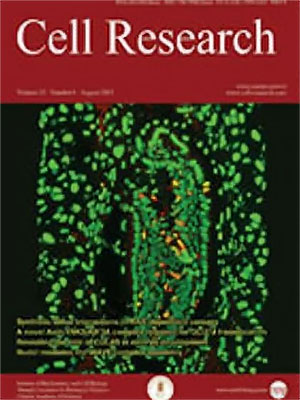
Volume 14, No 4, Aug 2004
ISSN: 1001-0602
EISSN: 1748-7838 2018
impact factor 17.848*
(Clarivate Analytics, 2019)
Volume 14 Issue 4, August 2004: 268-282
ORIGINAL ARTICLES
Identification of a novel population of human cord blood cells with hema-topoietic and chondrocytic potential
Karen E JAY1,2, Anne ROULEAU1, T Michael UNDERHILL3, Mickie BHATIA1,2,3,*
1Stem Cell Biology and Regenerative Medicine, The John P. Robarts Research Institute, 100 Perth Drive, London, Ontario, N6A 5K8, Canada.
2Department of Microbiology and Immunology, The University of Western Ontario, London, Ontario, Canada.
3Department of Physiology, The University of Western Ontario, London, Ontario, Canada.
Correspondence: Mickie BHATIA(mbhatia@robarts.ca)
With the exception of mature erythrocytes, cells within the
human
hematopoietic system are characterized
by the cell surface expression of the pan-leukocyte receptor CD45. Here,
we identify a novel subset among mononuclear cord blood cells depleted
of lineage commitment markers (Lin
-) that are devoid of CD45
expression. Surprisingly, functional examination of Lin
-CD45
- cells also lacking cell surface CD34 revealed they were capable of
multipotential hematopoietic progenitor capacity. Co-culture
with mouse embryonic limb bud cells demonstrated that Lin
-CD45
-CD34
- cells were capable of contributing to cartilage nodules and differentiating
into human
chondrocytes. BMP-4, a
mesodermal factor known to promote
chondrogenesis, significantly
augmented Lin
-CD45
-CD34
- differentiation
into
class=SpellE>chondrocytes. Moreover, unlike CD34+ human class=SpellE>hematopoietic stem cells, Lin-CD45-CD34-
cells were unable to proliferate or survive in liquid cultures, whereas
single Lin-CD45-CD34- cells were able
to class=SpellE>chimerize the inner cell mass (ICM) of murine
blastocysts and proliferate in this embryonic
environment. Our study identifies a novel population of Lin-CD45-CD34-
cells capable of commitment into both hematopoietic
and chondrocytic lineages, suggesting that human
cord blood may provide a more ubiquitous source of tissue with broader
developmental potential than previously appreciated.
FULL TEXT | PDF
Browse 1932


